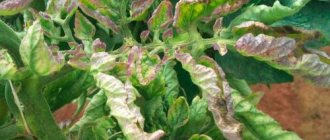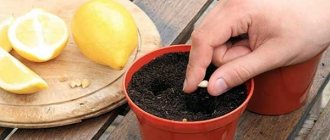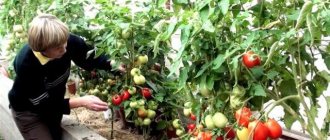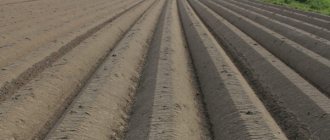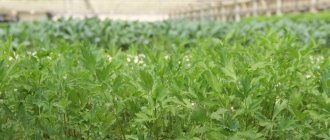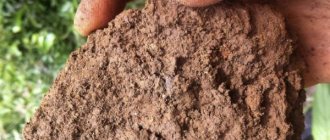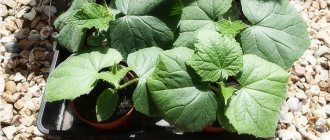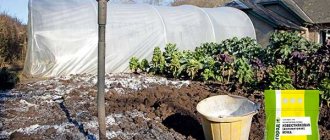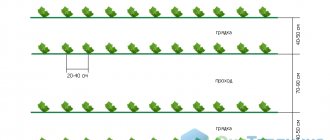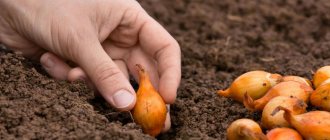Basic soil requirements for growing tomatoes
The soil composition requirements for growing tomatoes depend on the needs of the crop. The main indicators that should be assessed are:
- acidity;
- soil structure;
- humidity.
Tomatoes require soil rich in vitamins and minerals to grow and bear fruit effectively.
Attention! Growing tomatoes in open ground should take place in warm soil with sufficient lighting.
The powerful root system of tomatoes has many branches and shoots that grow in a wide range around the bush. They provide the plant with all the necessary nutrients, minerals and trace elements contained in the soil. The growth process of tomatoes, the quantity and volume of fruits depend on the quality composition of the soil.
Category: “Questions and answers”
Question No. 1 . Is it better to feed tomatoes with saltpeter or urea?
Ammonium nitrate is called urea and is used after seedlings have established themselves. On acidic soils, calcium nitrate is added, which neutralizes the pH level.
Question number 2 . How to change soil moisture?
Clay soils retain excess water. Coarse river sand is added for loosening.
Question No. 3. Why are earthworms sold?
The most commonly found on sale are California worms or prospectors. They are placed in compost to obtain vermicompost.
Soil acidity for growing tomatoes
One of the most important indicators that should be given great attention is soil acidity. The area where tomatoes are planted should have an acidity level in the range from 6 to 6.8. This is the optimal value, which was determined experimentally.
Soil acidity is a reaction of a chemical property, which is determined by the soil in the form of hydrogen concentration. Indicators obtained during scientific experiments are classified as follows:
| Soil character | Strongly acidic | Sour | Subacid | Neutral |
| pH | 4,5 | 4,5-5,0 | 5,0-5,5 | 5,5-7,0 |
Thus, we see that tomatoes prefer neutral soils. That is, if you have acidic soil in the area where you grow tomatoes, you should neutralize the acidity in various ways.
How to prepare the ground for seedlings
Seedling soil is prepared in the fall.
It is put into bags or boxes and stored outside. In winter, during frosts, harmful insects and bacteria will die, and the virgin soil becomes almost sterile. In spring, the soil is warmed up in advance and allowed to thaw naturally. To improve performance, add humus or compost and superphosphate. To improve the soil, peat, perlite, vermiculite and other materials are used that increase fertility and improve the mechanical qualities of the substrate.
The finished seedling soil should retain moisture well, be loose and nutritious.
The acidity and humidity of the finished substrate are checked with litmus paper. It should be at the level of 5.8-6.8.
Determining soil acidity
To determine the acidity of soil for tomatoes, it is optimal to carry out a chemical analysis in a special soil science laboratory. Experienced specialists will make calculations using high-precision equipment and determine not only the acidity index, but also the ratio of nitrogen, potassium, phosphorus and other elements necessary for tomatoes.
Soil acidity can also be determined:
- a special pH meter. The device is stuck into the ground and displays the acidity value accurate to tenths;
- litmus papers. Specialized stores sell ready-made sets of indicators for determining soil acidity. To carry out the analysis, the soil should be taken in several places and placed in distilled water. Each sample is first wrapped in a bandage or gauze. 5 minutes after immersion, litmus paper is lowered into the water. Acidity is determined by color;
It is important! A pink-orange color of a litmus indicator means an acidic reaction, a yellow tint means a slightly acidic reaction, and a greenish color means a neutral reaction.
- folk ways. For crops and weeds growing in the garden, as well as for independently conducted chemical experiments, as a result of which homemade indicators are prepared;
- reaction to mixing water, chalk and earth. The soil sample is placed in a bottle or jar, mixed with chalk powder and filled with water. A fingertip or glove is pulled on top. Filling rubber products with volume indicates an acidic soil reaction.
The most accurate and optimal way to determine soil acidity is in the laboratory. If you have such an opportunity, take advantage of it.
How to disinfect soil
The main enemy of tomatoes is late blight. You can get rid of it by spilling the bottom of the planting hole with a solution of Fitosporin or a weak solution of potassium permanganate. For pests, you can use ammonia infusion or onion peels.
There is also a folk method. Sawdust soaked in birch tar is placed at the bottom of the planting holes. And sprinkle earth on top. This composition has a pungent odor, which repels pests.
How to adjust acidity
If you find that your soil is highly acidic, you need to add lime. The basic rules of liming are:
- the procedure should be carried out in the spring before planting seedlings or in the fall after harvesting;
- the area must be free of weeds and other plants;
- the lime mixture must be thoroughly crushed;
- for liming you should choose a calm, clear day;
- lime is poured in a thin layer on the ground.
Digging the earth mass to a depth of 20 cm will ensure the mixing of earth and lime, as well as the introduction of the composition into the deeper layers. As a result, neutralization reactions occur in the soil.
Depth of groundwater and drainage methods
This indicator is especially important in marshy soils, since tomatoes do not tolerate excess moisture.
In addition to marsh plants, “high” water is determined by digging a stepped hole in the spring in April, or in the fall in October, when the water level is as close as possible to the surface of the earth. If water appears at a depth of 1 m and remains (“does not go away”) for several days, this means that drainage is necessary to plant the tomato.
Tomatoes do not like excess moisture. There are two ways to adjust the level of natural underground water:
- Adding imported soil.
- Drainage system.
The first option requires a retaining wall that holds the purchased soil. It is not necessary to build it along the entire area of the site. For example, it is enough to carry it out where a vegetable garden with tomatoes is planned. A drainage system is built throughout the entire site, and the receiving pipe is led to a storm water inlet or to a reservoir located in the lower part of the garden.
Soil moisture
Important attention should be paid to the natural moisture of the soil. Tomatoes prefer well-aerated and moist soils. Tomatoes should not be planted in marshy or clayey areas. Over-watering will lead to rotting of the roots.
Choose a site for planting tomatoes where the groundwater is low. To determine the depth of the upper aquifer, evaluate drainage ditches and depressions in the soil. If after rain there is high water in the ditches that does not go away for a long time, this means high groundwater. Choose elevated areas to grow tomatoes.
Regular watering of the crop should be organized. In dry weather, tomatoes are watered once a day in the afternoon. Settled water is used for irrigation.
Plants characteristic of soils of varying moisture content
If you don’t have a device, you can take a closer look at the natural vegetation on the site. On dry sandy soils grow:
- White sweet clover,
- Feather grass
- cat's paw,
- Forget-me-not small-flowered,
- Acrid sedum,
- Gerbil angustifolia,
- creeping thyme,
- Common chicory
- Chistets fluffy
- Hairy hawkweed.
Excessive moisture, close to a swamp, will show:
- Marsh marigold,
- Blackberry sedge, coastal, swamp,
- Meadowsweet,
- Creeping buttercup,
- Forget-me-not swamp,
- Water pepper.
Swamp plants also characterize the high location of groundwater.
Qualitative composition of soils for growing tomatoes
The land on which tomatoes will be planted must contain a sufficient amount of:
- potassium;
- phosphorus;
- nitrogen.
The soil should also contain elements such as manganese, zinc, and selenium.
The soil for growing tomatoes must have a loose structure. This ensures optimal absorption of moisture and all necessary nutrients by the root shoots. Loose soil distributes moisture well and provides the necessary aeration. Waterlogged or clayey soils can cause root rot due to excess moisture.
The area where tomatoes grow should be weeded regularly to prevent weeds from growing. They not only rob the crop of valuable moisture and nutrients and create a lack of sunlight, but can also dump their seeds into the soil. To prevent this, it is necessary to remove weeds at the first shoots.
This is useful! To provide the soil for growing tomatoes with potassium, you need to add potassium salt or wood ash. Ammonium nitrate is used to add nitrogen. Phosphorus is applied using ready-made superphosphate fertilizer.
Another important soil requirement for growing tomatoes is the absence of pests. Larvae in the ground and harmful insects can destroy the entire crop. You should regularly take preventive measures against the appearance of fleas, aphids, midges, mold and viruses. This is provided by ready-made chemical solutions, which are sold in specialized stores, or is achieved by folk methods.
Planting green manure
There is one more important question. What are these weeds we have here? It was we who sowed winter crops before winter - oats and vetch. The fact is that the soil structure has improved. This year, literally a week ago, they dug it all up. There is no need to be afraid of this. Some gardeners are afraid and do not plant green manure either in the fall or in the spring. If you have time to plant in the spring, no problem. In a month or a month and a half, they will sprout and improve the soil with both structure and nutrition.
For example, vetch is a legume that is often planted to nourish the soil. Look at the roots here. There are some white tubers on the roots, like knobs. This is nothing more than nitrogen. These are nitrogen-fixing tubers. And, it is clear that now we will not need nitrogen before fruiting. And maybe even more if last year’s food is enough. Because we contributed a lot. We always say that if you add nutrients once, you don’t have to add them another time. You can simply use crop rotation to select crops that require less nutrition. And this vermicompost will still work. In the third year, plant another crop that consumes very little.
We planted tomatoes last year and we are planting tomatoes this year. There is nothing else left for us. There is little space, nowhere to roam. Therefore, we will contribute food. First we must disinfect the soil. We do this both in the fall and early spring. We treated the soil with pharmaiod. So, I hope we are free of diseases, pests, etc.
How to organize a bed in open ground for tomatoes
Experienced gardeners use high beds to grow tomatoes, filling them with soil of the optimal composition. To do this, choose a well-lit place without drafts on the site, where:
- install a box of boards or other available material up to 30 cm high. It is important that the joints fit securely to each other in order to prevent soil from being washed out;
- Garden soil is brought into the box. You can dig it up nearby. Layer height is at least 15 cm;
- pour a peat mixture with an acidity of 6.5 about 5 cm high;
- add river sand in a layer of 1-2 cm;
- add wood ash;
- Apply mature compost or rotted manure in a layer of 10 cm.
All components are dug up with a bayonet shovel to a depth of 30 cm. As a result, you get soil that contains all the ingredients for a rich tomato harvest. This composition can be used both for preparing seedlings and for growing tomatoes in greenhouse conditions.
What kind of soil do tomatoes need in a greenhouse?
The greenhouse will be a good place for tomatoes. It will save the harvest from bad weather and temperature changes. But you need to take care of the soil in which they will grow. What qualities come with good soil?
- Tomatoes love warm soil full of vitamins and microelements.
- Also, these vegetables like loose and moist soil, but not swampy. You can check: if you hold the soil in your fist, a lump forms, but when pressed, it crumbles.
- Clean from roots and weed seeds.
- Disinfected substrate, disinfected from small pests.
- With an acidity level of up to 7 pH.
Preparing the soil in a greenhouse for the so-called “golden apples” takes time, so it is worth preparing the soil in advance. It is also worth considering that in previous years nothing grew in this bed that could negatively affect the tomatoes. The best predecessors would be pumpkins, beans or any root vegetables.
More information about the rules of crop rotation for vegetable crops.
Mistakes gardeners make when preparing and caring for soil for tomatoes
Some gardeners underestimate the importance of soil acidity for growing tomatoes and its quality composition. The most common mistakes in soil care are:
- lack of acidity control. Tomatoes will not produce a bountiful harvest if you do not monitor the acidity. Tomatoes prefer neutral soils;
- unsystematic application of organic fertilizers. The addition of mullein, manure and compost changes the acidity of the soil. You should follow the recommendations of agronomists on the timing of organic matter application;
- failure to apply ready-made fertilizers or natural nutritional infusions. Neglecting to feed tomatoes also has a detrimental effect on their development and fruit formation. The soil is quickly depleted and the plant is deficient in nutrients;
- fertilization with compost of inadequate quality. Adding compost to the soil, which uses unacceptable components, affects the quality of the soil. When organizing a compost pit, you should not store pet feces, colored glossy paper, or acidic peat in it. You should also give the compost time to rot;
- adding fresh manure to the soil. Using fresh mullein or bird droppings in their pure form can increase the acidic or alkaline reaction of the soil. It is necessary to wait time for the chemical reactions of neutralization and decomposition to occur in the manure.
Gardeners should also pay attention to soil moisture.
Improving additives for various types of soil - clay, loam, sand
If the natural soil on a site does not meet the required parameters, then to optimize it, substances are added that change the structure of the soil. Recommendations for the use of structuring agents:
| Soil type | Improvement additive. Features of application. | Application dose |
| Sandy | Organic fertilizers, such as compost or humus. | 4 – 6 kg/m2 |
| Lowland peat | 4 – 5 kg/m2 | |
| Sod land. | 1:1 | |
| Medium loam | Lowland peat enriches the soil with air, but changes the pH towards acidification. | 2 – 3 kg/m2 |
| Clay | High-moor peat loosens the soil, but acidifies it. Apply only before winter, along with a neutralizing agent (slaked lime). | 2 – 3 kg/m2 |
| Coarse sand | 80 – 100 kg/m2 | |
| Compost, sand sapropel | 1:1:2 | |
| All soil types | Sapropel | 1:1 |
High-moor peat rots (decomposes), releasing harmful substances for tomatoes. It is placed in compost or added to the soil in advance, in the fall.
